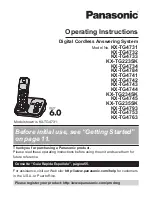
120
Glossary
Gigaset DL500A / GRC EN / A31008-N3103-T101-1-7619 / Glossary.fm / 31.08.10
V
e
rsion 4, 16.0
9
.2005
DynDNS
Dynamic DNS
Domain names and IP addresses are
assigned via
this service is enhanced with "Dynamic
DNS". This permits the use of a network com-
ponent with a dynamic IP address as a
on the
. DynDNS ensures
that a service can always be addressed on
the Internet under the same
,
regardless of the current IP address.
E
ECT
Explicit Call Transfer
Participant A calls participant B. The partici-
pant puts the connection on hold and calls
participant C. Rather than connect everyone
in a three-party conference, A now transfers
participant B to C and hangs up.
EEPROM
Electrically Eraseable Programmable Read Only
Memory
Memory building block in your phone with
fixed data (e.g., default and customised set-
tings) and data saved automatically (e.g., call
list entries).
Ethernet network
F
Firewall
You can use a firewall to protect your net-
work against unauthorised external access.
This involves combining various measures
and technologies (hardware and/or soft-
ware) to control the flow of data between a
private network you wish to protect and an
unprotected network (e.g., the Internet).
See also:
.
Firmware
Device software in which basic information
is saved for the functioning of a device. To
correct errors or update the device software,
a new version of the firmware can be loaded
into the device's memory (firmware update).
Fixed IP address
A fixed IP address is assigned to a network
component manually during network con-
figuration. Unlike the
fixed IP address does not change.
Flat rate
Billing system for an
connection.
The Internet provider charges a set monthly
fee. There are no additional charges for the
duration of the connection or number of
connections.
Full duplex
Data transmission is a mode in which data
can be sent and received at the same time.
G
G.711 a law, G.711 μ law
Standard for a
.
G.711 delivers a very good voice quality that
corresponds to that in the ISDN network. As
there is little compression, the necessary
bandwidth is around 64 kbit/s per voice con-
nection, but the delay caused by coding/
decoding is only approx. 0.125 ms.
"a law" describes the European standard and
"μ law" describes the North American/Japa-
nese equivalent.
G.722
Standard for a
.
G.722 is a
broadband
language codec with a
bandwidth of 50 Hz to 7 kHz, a net transmis-
sion rate of 64 kbit/s per voice connection
and integrated speech pause recognition
and comfort noise generation (silence sup-
pression).
G.722 delivers very good voice quality. A
higher sampling rate provides clearer and
better voice quality than with other codecs
and enables a speech tone in High Definition
Sound Performance (HDSP).
G.726
Standard for a
.
G.726 delivers a good voice quality. It is infe-
rior to the quality with codec
G.711
but bet-
ter than with
G.729
.
















































